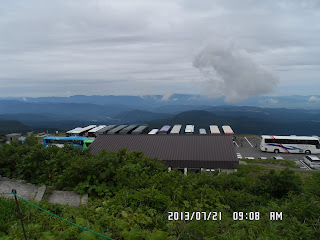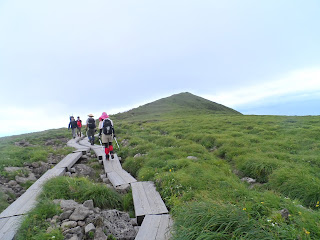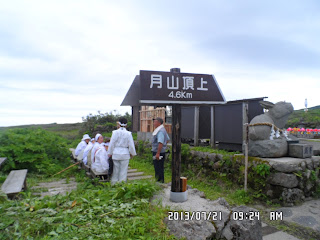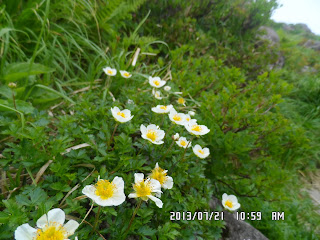130721 Mt. Gassan(月山、갓산), Yamagata Prefecture(山形県야마가타 현)
Mount Gassan (月山 Gassan) is the highest of the Three Mountains of Dewa in the ancient province of Dewa (modern-day Yamagata prefecture). The Gassan Shrine stands at the mountain's summit, 1984 meters above sea level.
Due to heavy winter snowfall, the mountain and shrine are inaccessible for long periods of the year; however, skiing is possible on the mountain from April to mid-summer. (From wikipeida)
http://en.wikipedia.org/wiki/Mount_Gassan
Date: July 21 (Sun) Cloudy, occasional rain
Place: Mt. Gassan (1,984m) in Bandai-Asahi National Park, Yamagata Prefecture, Japan
Hiking Course: The 8th Station Bus Stop(9:00) → Midagahara Lodge)9:25) → Saino-kawara(9:44) → Bussho Pond (The 9th ST Lodge 11:04)) → Gyosha-gaeshi Point(11:44) → Gassan Shrine (the summit12:30) → Ushiku(13:17) → Kanauba(13:34) → Iron Ladder (14:16) → Yudonosan Hongu Bus Stop(14:45)[About 10 km, 5 hours and 45 minutes, altitude difference: about 500 m)
Transportation from Tsuruoka: S-Mall → Hagurosan Summit → The 8th ST of Gassan,
Return Trip: Yudonosan Hongu → Yudonosan Bus Stop → S-Mall
Partner: None
After attending the class-reunion of elementary school at Zushi, I went back to Ofuna Station and joined my wife.
Together, we went to Shibuya, and saw my wife’s sister at Shibuya. We went to the long-distance overnight bus stop on the building.
The bus to Tsuruoka left at midnight and arrived at Tokyo Daiichi Hotel in Tsuruoka at 6:15 am. My wife’s brother picked my wife and her sister up there.
I stayed at Daiichi Hotel, then went to JR Tsuruoka Station, bought some food and drinks for the day and went to S-Mall where the bus to Hagurosan left.

[JR Tsuruoka Station, JR鶴岡駅、JR 쓰루오카 역]
The bus to Hagurosan Summit (羽黒山山頂行き) left at 7 am and I changed the buses at Hagurosan Summit Bus-Stop, then headed for the 8th Station of Gassan (1,300m) at 9:00 am. The bus fare from S-Mall to the 8th ST of Gassan was 2000 yen.

[The bus bound for Hagurosan Summit, 羽黒山頂行きバス、하구로 산정 행 버스]
It was cloudy that day. I could see the Shonai Plain rather well, but Mt. Chokai (elevation of 2,236m) was in the cloud. So, I could not see the whole mountain well.

[Dandelion and cabbage butterfly,モンシロチョウとタンポポ、배추 흰나비와 민들레]

[Mt. Chokai (2236m) from the bus-stop, バス停から見た鳥海山、버스 정류장에서 본 초카이산(2236m)]

[Alpine flora "Hakusan-furo", ハクサンフウロ、하쿠산후우로 (고산 식물)]

[Gassan 8th ST Parking Lot, 月山八合目バス駐車場、갓산 8부 능선 버스 주차장]

[Info about Gassan Nakanomiya Shrine and Sanrojo, 月山中の宮と参籠所の案内、갓산 "나카노미야"신사와 "산로죠"의 안내]

[Parking Lot and Shonai Plain, 駐車場と庄内平野、주차장와 쇼나이 평야]

[Alpine flora "Hakusan-furo", ハクサンフウロ、하쿠산후우로 (고산 식물)]

["Nikkokisuge" or a kid of "Tiger Daylily"、ニッコウキスゲ、원추리]

[A kind of alpine flora, 高山植物の1種、고산 식물의 1 종]
I arrived at Midagahara Sanrojo(御田原参籠所) at 9:25. “Sanro(参籠)” means to confine oneself in a shrine to pray. So, it is the place for people to cofine themselves in a shrine to pray. Actually it is nothing different from a lodge. Hikers can stay overnight, and have meals, but the meals are vegetarian diet just like temple stay.

[Midagahara Sanrojo Lodge, 御田原参籠所、미다가하라 산로죠]

[A stone rabbit at Sanrojo, 参籠所前のウサギの像、"산로죠"앞에 토끼의 석상]
The beautiful field around the 8th station of Gassan is called “Midagahara (弥陀ケ原).” And the sacred lodge of the 8th station of Gassan was also called “Midagahara(御田原)” but Chinese characters are different.

[Midagahara Shrine, 御田原神社、미다가하라 신사]
It might be changed into that way when Haibutsu kishaku (廃仏毀釈) (literally "abolish Buddhism and destroy Shākyamuni") movement was occurred in the early Meiji Period (1860s.)
Haibutu Kishaku:
http://en.wikipedia.org/wiki/Haibutsu_kishaku
It is said that even the temples related to the famous haiku poet, Matsuo Basho was completely destroyed at Mt. Haguro, one of the Dewa Three Mountains.
Anyway, “Mida(弥陀)” of “Midagahara” means “Amitābha(阿弥陀如来)”
http://en.wikipedia.org/wiki/Amit%C4%81bha
So that’s why they changed the Chinese Characters from (弥陀) to (御田)
There are still remains the custom of Buddhism around Midagahara Sanrosho Lodge, such as stone statues of jizo, and windmills. (Windmills are simble of cycle of rebirth(輪廻) at the same time, for kids (who died in early stages of their live.)

[Statutes of jizo in front of Midagahara Shrine, 御田原神社前の地蔵群、미다가하라 신사 앞의 지장 보살들]
I also noticed a wooden cenotaph built in memory of victims of “Aftermath of the 2011 Tōhoku earthquake and tsunami.”

[A cenotaph for the victims of East Japan Great Disaster,東日本大震災犠牲者慰霊塔、동일본 대지진 희생자 위령탑]
There were “Chito(池塘)” which were peculiar in Oze and Midagahara. It is a kind of small pond, and named as Buddhism related names such as “Muryonoike(無量の池)”

[A kind of alpine flora, 高山植物の一種、고산 식물의 일종]

[Alpine flora "Hakusan-chidori" 高山植物『ハクサンチドリ』、고산 식물 "하쿠산 치도리"]
However, as I walked higher and higher, I could see vast amount of snow in the field. At the same time there were plenty of alpine flora along the trails and in the field.

["Chito" ponds and remaining snow, 『池塘』と残雪、"지당"연못과 잔설]

[Rhododendron brachycarpum, ハクサンシャクナゲ、만병초(萬病草)]

["Sainokawara" or the Children's Limbo, 賽の河原、"사이노카와라"(죽은 아이가 저승에서 부모의 공양을 위해서 돌을 쌓아 탑을 만든다는 삼도(三途)내의 모래 강변)]

[Alpine flora "Usagi-giku", 高山植物『ウサギギク』、고산 식물 "우사기기쿠"]

[Thistle、アザミ、엉겅퀴]

[Near the 9th ST, 九合目付近にて、9부 능선 부근에서]

[A kind of alpine flora, 高山植物の一種、고산 식물의 일종]

[Near the 9th ST, 九合目付近にて、9부 능선 부근에서]

[A kind of alpine flora, 高山植物の一種、고산 식물의 일종]
When I came close to the 9th Station, the trail was covered with heavy snow. I had to walk on the snow carefully.

[Near the 9th ST, 九合目付近にて、9부 능선 부근에서]

[A kind of alpine flora, 高山植物の一種、고산 식물의 일종]
Again I saw plenty of alpine flora such as “Chinguruma” or “Nikko-kisuge,” etc.

[Alpine flora, Chinguruma, 高山植物『チングルマ』、고산 식물 "찐구루마"]

[Alpine flora "Usagi-giku", 高山植物『ウサギギク』、고산 식물 "우사기기쿠"]
When I arrived at the 9th Station, there was a lodge and a pond named “Busshoike仏生池.” Again the name is obviously related to Buddhism and there were 4 small jizo statute.

[Busshoike Lodge, 仏生池小屋、붓쇼이케 산장]

[Four statutes of jizo, 4地蔵菩薩、4 개의 지장 보살 석불]
I used a bathroom at the 9th Station. The chage was 100 yen. I thought it was reasonable.
When I passed the 9th station of the mountains, the amount of snow increased. I saw people wearing white close and straw hats. I wonder if they were trainees of certain religious purpose, or just fashions.

[People wearing religious training wears, 修業者の衣装を身に着けた人々、수업의 의상을 입은 사람들]

[Near the 9th Station, 九合目付近にて、9부 능선 부근에서]

["Haru-rindo" (a Japanese gentian), ハルリンドウ(春竜胆)、"봄" 용담]

[Edelweiss,エーデルワイス、에델바이스]

["Iwagikyo", イワギキョウ、"이와기쿄오"(바위 도라지)]

[Wooden trails around the 9th ST, 九合目付近の木道、9부 능선 부근의 목도]
When I came close to the top of the mountain, again there were much snow left. It was about noon and I had lunch there.

[Snow near the summit, 頂上付近の残雪、정상 부근의 잔설]

["Iwakagami"、イワカガミ(岩鏡)、이와카가미 (바위 거울)]
I put a can beer into the snow. The beer was cool and tasted good.

[Alpine flora near the summit, 頂上付近の高山植物、정상 부근의 고산 식물]

[People around the summit, 頂上付近で休憩する人々、정상 부근에서 휴식하는 사람들]

[Alpine flora near the summit, 頂上付近の高山植物、정상 부근의 고산 식물]
When I arrived at the summit of Mt. Gassan, it brew strong wind, and I felt too cool almost cold.

[The explanation of Gassan Shrine, 月山神社本宮の由来、갓산 신사 본궁의 유래]

[The entrance of Gassan Shrine, 月山神社本宮の入り口、갓산 신사 본궁 입구]
I arrived at the summit of Gassan at 12:30. There is Gassan Shrine on the top of the mountain, and people cannot enter the shrine unless they pay fee for “Oharai”, or “Shinto’ exorcism ceremony.” I gave up going into the shrine.

[A view from the summit, 月山山頂付近からみた風景、갓산 정상 부근에서 본 풍경、]
I just took pictures around the entrance of the shrine, and the views of mountains from the area around the shrine.
I saw a big stone curved as “Hakkoichiu八紘一宇.” Below is the explanation of “Hakkoichiu” from Wikipedia.

[A stone monument of "Hakkoichiu", 八紘一宇と書かれた石碑、"팔굉 일우"라고 적힌 비석]
Hakkō ichiu (八紘一宇, literally "eight crown cords, one roof" i.e. "all the world under one roof") was a Japanese political slogan that became popular from the Second Sino-Japanese War to World War II, and was popularized in a speech by Prime Minister of Japan Fumimaro Konoe on January 8, 1940.

[Now I began descending, 下山開始、하산 시작]

[The Gassan Summit Lodge, 月山山頂小屋、갓산 산정 산장]
Now I began heading toward Mount Yudono (湯殿山). It was rather steep slope I began descending. At that time there were many people since it was Sunday.
I noticed that there was Inari Shrine along the trail. At Inari shrine they regard foxes as messengers of the god. I saw many small foxes at the shrine.

[Inari Shrine along the trail, 下山路の稲荷神社、하산로의 이나 리 신사]

[Jizo Statue for Apothanasia、延命地蔵尊、연명 지장 보살]

[Descえんending toward Yudonosan, 湯殿山方面へ下山、유도 노산 방면으로 하산]
As I descend the mountain, I saw another vast mount of snow. I also noticed that some people were skiing on the slope. It was Gassan Skiing Resort.

[Many people were skiing, 多くの人々がスキーをしている、많은 사람들이 스키를 타고있다.]

[Geum pentapetalum or "Chinguruma", チングルマ、고산 식물 "찐구루마"]

[Gassan Skiing Resort, 月山スキー場、갓산 스키장]
At Ushiku (牛久), there were two trails: one to the skiing resort, the other to Yudonosan Shrine. I turned to the latter.
Again there were beautiful alpine flora along the trails, and snow. I could not help but taking many pictures.

[Alpine flora near Ushiku, 牛久付近の高山植物、우시쿠 부근의 고산 식물]

["Iwakagami" along the trail, 下山路の『イワカガミ』、하산 길의 "이와카가미"]

[Trail toward Yudonosan, 湯殿山方面の登山路、유도노산 방면의 등산로]

[Alpine flora near Kanauba, 金姥付近の高山植物、"카나우바" 부근의 고산 식물]

[A guidepost at Kanauba, 金姥の里程標、카나 우바의 이정표]

[Remaining snow near Kanauba, 金姥付近の残雪、카나 우바 부근의 잔설]
[Alpine flora near Kanauba, 金姥付近の高山植物、카나 우바 부근의 고산 식물]

[Alpine flora, "Tsugazakura" ツガザクラ(栂桜)、고산식물 쓰가자크라]
When I came to the last snow covered area, my camera battery was gone.
Some hikers were wrapping straw ropes around their hiking boots, to prevent sliding on the snow. I walked carefully on the snow.

[The last snow covered trail, 下山路最後の雪渓、하산로 마지막 눈 골짜기]
Then the trail became like streams because of melted snow. Moreover it began raining a little bit.
The slopes became really steep and there were iron stairs here and there.
When I came to Yudonosan Hongu Shrine, there was a shuttle bus between Hongu and Yudonosan Sanrojo Bus Stop. It was just 3 pm.

[The shuttle bus, シャトルバス、셔틀 버스]

[A map of Yudonosan Shrine, 湯殿山神社の絵地図、유도노산 신사의 그림 지도]
The next bus to Tsuruoka was at 4:45. I had to wait for 1 hour and 45 minutes.
So, I went to Yudonosan Sanrojo. It was like a hotel, a big building, not like Gassan Sanrojo Lodge.
I could use the hot-spring facility there and took a bath there.
I also had ramen, and waited for the bus.
The bus left Yudonosan at 4:45 pm. There were only 6 passengers including myself. It took one hour and 15 minuts to S-Mall in Tsuruoka. It cost 1770 yen.
The bus driver voluntarily guided along the way. So it was like a sightseeing bus. I could enjoy listening to his explanations for nearly one hour.
The bus arrived at S-Mall at just 6 pm. There was no bus service available then to the village where my wife’s brother’s house was.
So, I took a taxi to Hodashi Village. The fair was 1480 yen. I joined the big dinner at my wife’s brother’s home.
--------------------------------------------------------------------------------------------------------
分類:登山、日本、東北, 日本百名山(Best 100 Mountains in Japan)
月山は、山形県の中央部にあり、出羽丘陵の南部に位置する標高1,984mの火山。山域は磐梯朝日国立公園の特別区域に指定され、日本百名山、新日本百名山、花の百名山及び新・花の百名山に選定されている。また、山麓は月山山麓湧水群として名水百選、月山行人清水の森として水源の森百選にも選定されている。
[ウィキペディアより「月山」]
登山日:2013年7月21日(日)曇り、一時雨
登山目的地:磐梯朝日国立公園の月山(1,984m)
登山コース:月山八合目(9:00)→御田原参籠所(9:25)~賽の河原(9:44)~仏生池(11:04)~行者返し(11:34)~月山神社(山頂12:30)~牛首(13:11)~金姥(13:34)~鉄梯子(14:11)~湯殿山本宮バス停(14:45)(所要時間5時間45分、全行程約10km、標高差500m)
鶴岡からの交通機関:[往路]Sモール → 羽黒山山頂 → 月山八合目、[復路]湯殿山本宮 → 湯殿山バス停 → Sモール
パートナー:なし
前夜、逗子で開催された小学校の同窓会後、私は一足先に会場を抜け出し、大船駅で妻と合流後渋谷へ向かった。
渋谷を深夜に出発した夜行バス「夕陽」は予定通り6時15分、鶴岡の東京第一ホテルへ到着した。
妻の兄が車で妻と妻の姉をピックアップしたが、私は月山に登るためそのまま残り、鶴岡駅のコンビニでお握りとお茶を調達した。
その後Sモールへもどり、7時発の羽黒山行きバスに乗った。

[A poster of Summer Skiing at Gassan, 月山夏スキーのポスター、갓산 여름 스키 포스터]
バスは羽黒山で小休止後、月山八合目へ向かって走った。料金は通しで2000円。時刻はちょうど9時だった。

[Dandelion and cabbage butterfly,モンシロチョウとタンポポ、배추 흰나비와 민들레]
この日の天気は曇りだが、ふもとの庄内平野は良く見える。海抜2,236mの鳥海山は雲がかかって全ぼうをみうことはできない。
[The guidepost to Gassan trail entrance, 月山登山口への標識、갓산 등산로에의 표지판]

[Alpine flora "Hakusan-furo", ハクサンフウロ、하쿠산후우로 (고산 식물)]

[Near the entrance of the trail, 登山路入口付近にて、등산로 입구 부근에서]

[Map of Gassan Midagahara, 月山弥陀ヶ原の案内図、갓산 미다가하라의 안내도]

[A guidepost at Midagahara, 弥陀ヶ原の里程標、미다가하라의 이정표]

[Parking Lot and Shonai Plain, 駐車場と庄内平野、주차장와 쇼나이 평야]

[Alpine flora "Hakusan-chidori" 高山植物『ハクサンチドリ』、고산 식물 "하쿠산 치도리"]

[A view of Chokaisan(2236m), 鳥海山、조카이산(해발 2236m)]
御田原参籠所には9:25到着。この「御田原参籠所」の読み方は「みだがはらさんろうじょ」であり、この付近の湿原は月山八合目の「弥陀ヶ原湿原」と呼ばれる。

[Midagahara Sanrojo Lodge, 御田原参籠所、미다가하라 산로죠]

[In front of Sanrojo, 参籠所前にて、"산로죠" 앞에서]
もともと「弥陀ヶ原」であったものを明治時代の廃仏毀釈で仏教行語である「弥陀」を「御田」と書き換えたものらしい。
また「参籠所」とは「参籠所とは、一定の期間籠って神仏にお祈りする施設のこと。」であるが、現在は神社の信徒でなくとも一般の人も宿泊できる施設で、山小屋とことなるのは料理が「精進料理」がでることぐらいか。
さて、ここは神社ではあるが、「弥陀」とは「阿弥陀如来」のことであるから、仏教の施設でもあったはず。6月29日の大山登山の下山で訪れた「白髯神社」を「日向神社」と言い換えたことや「日向薬師」の受難でもふれたように、出羽三山の「廃仏毀釈」による「仏教寺院」の受難は大きかったようである。
例えば羽黒山には南谷別院跡があるが、これは廃仏毀釈で破壊つくされた寺の後だと言う。現在は松尾芭蕉の句碑があるのみである。
だが、現在では仏教の風習も許されているようで、仏教の輪廻を思わす風車の他、新しい地蔵や塔婆が目につく。

[Statutes of jizo in front of Midagahara Shrine, 御田原神社前の地蔵群、미다가하라 신사 앞의 지장 보살들]
また、先の東日本大震災の大きな供養塔も目についた。

[The Torii of Gassan Main Shrine, 月山本宮の鳥居、갓산 본궁의 도리이]
さて、私は石畳のような緩やかな登山路を月山山頂に向かって歩いた。御田原参籠所の先には池塘がちらほらと見えた。

[A kind of alpine flora, 高山植物の一種、고산 식물의 일종]
このうちの山に向かって右側の池塘の名前は「無量の池」という仏教的な名前が付いている。

[The Muryo Pond, 無量の池、무량의 연못]
このあと、登山路の両側は笹薮になるが、長くは続かず、これをを抜けるとまた一面高山植物のお花畑だ。

[Thistle、アザミ、엉겅퀴]

["Nikkokisuge" or a kid of "Tiger Daylily"、ニッコウキスゲ、원추리]

[Alpine flora "Usagi-giku", 高山植物『ウサギギク』、고산 식물 "우사기기쿠"]

["Haru-rindo" (a Japanese gentian), ハルリンドウ(春竜胆)、"봄" 용담]

[Near the 9th ST, 九合目付近にて、9부 능선 부근에서]
高度を上げるに従い、下の方の残雪とともに、大量の雪が行く手にあらわれた。ところどころ残雪の上をトラバースする。
頂上へあと1キロほどの雪原で、セルフタイマーで1枚撮影した。これが今回唯一の自分の写真である。

[George near the 9th ST, 九合目付近にて、9부 능선 부근에서]

[Rhododendron brachycarpum, ハクサンシャクナゲ、만병초(萬病草)]
このあたりからはイワカガミやチングルマの数が増える。仏生小屋には11:04に到着。ここにはかわいい4地蔵があった。

[Alpine flora, Chinguruma, 高山植物『チングルマ』、고산 식물 "찐구루마"]

[Busshoike Lodge, 仏生池小屋、붓쇼이케 산장]

[The Bussho Pond and jizo, 佛生池と地蔵菩薩、붓쇼이케 연못과 지장 보살 석상들]
仏生池ではトイレを使用。料金は100円。また、ここではゴザを利用したお賽銭置き場があり、このお賽銭は活用している模様。

[Straw mat for money offering, ゴザを敷いた賽銭箱、돗자리 새전 보관소]
仏生池を過ぎるとお花畑の花の種類も若干変化があるようだ。また、登山道もかなりきつくなり、「行者返し」という標識があった。

[The guidepost of "Gyosha Gaeshi" 『行者返し』の標識、"수도자 반환"표지판]
植生も変わり、エーデルワイスや青いベルのようなイワギキョウもこの頂上付近でのみ見えた。

[Edelweiss,エーデルワイス、에델바이스]
また、白装束に身を包んで木の杖を1本持った修行者のような人々もよく見かけた。彼らは宗教的な登山をしているのだろうか。

[Near the 9th Station, 九合目付近にて、9부 능선 부근에서]

["Iwagikyo", イワギキョウ、"이와기쿄오"(바위 도라지)]

[Snow near the summit, 頂上付近の残雪、정상 부근의 잔설]
残雪の量も増え、ハクサンシャクナゲの花も目につく。月山神社がみえるころ12時になり、そのすぐ近くの雪原の縁で昼食にした。

["Iwakagami"、イワカガミ(岩鏡)、이와카가미 (바위 거울)]

[People walking on the snow, 雪の上を歩く人々、눈 위를 걷는 사람들]
雪の中に缶ビール1個を埋めて冷やし、コンビニで調達した握り飯を食べた。

[Snow near the summit, 頂上付近の残雪、정상 부근의 잔설]

[Alpine flora near the summit、頂上付近の高山植物、정상 부근의 고산 식물]
頂上付近は風がやや強く半袖では少し寒い。生憎、長袖のジャンバーや防風着は持参しなかったが、耐えられないほどの寒さではない。
短い昼食後、歩き始め、月山頂上本宮には12:30に到着。ここは代金を払って御はらいを受ける人のみが入れる場所で、今回も入り口を撮影しただけですました。入口の横には月山神社本宮参拝認定書の大きな看板が掲示してあった。

[The entrance of Gassan Shrine, 月山神社本宮の入り口、갓산 신사 본궁 입구]

[Worship certificate of Gassan Shrine、月山神社本宮参拝認定書、갓산 신사 본궁 참배 인정서]
お金を払って神社内に入っても境内は撮影禁止だ。また、私はクリスチャンであるから神道の御祓いをしてもらうわけにはいかない。

[In front of the Gassan Shrine, 月山神社本宮前にて、갓산 신사 본궁 앞에서]
さて、神社のまわりにはさまざまな石碑があり、なかでも「八紘一宇」と大書した大きな石碑が目についた。戦前、戦中にかけて、戦勝を祈願してこの碑が建てられたのだろう。

[View around the summit,山頂付近の石碑群、정상 부근의 비석들]
ここからの眺めはよく、雪を抱いたゆるやかな山々を展望することができた。その後、尾根伝いに湯殿山へ向かうことにした。
頂上を過ぎるとややけわしい下りの登山路でおまけに登山客も多く、今回唯一の渋滞地域となった。
頂上付近に稲荷神社があり、「正一位稲荷神社」と書かれた札の先には狐の小物が置いてある。この辺が登り客と下り客が一番混雑していた。

[Inari Shrine along the trail, 下山路の稲荷神社、하산로의 이나 리 신사]

[Hikers descending Gassan, 月山から下山する人々、갓산에서 하산하는 사람들]

[Descえんending toward Yudonosan, 湯殿山方面へ下山、유도 노산 방면으로 하산]
稲荷神社を過ぎると眼下にスキー場が見えてくる。スキー場と湯殿山への登山路の分岐点である牛首には1:17に到着。

[Gassan Skiing Resort, 月山スキー場、갓산 스키장]

[The guidepost of Ushiku, 牛久の標識、"우시쿠" 표지판]

[A skier on the snow, スキーヤー、스키를 탄 사람]

["Chinguruma" near Ushiku, 牛久付近のチングルマ、우시 쿠 부근의 찐구루마]
このころ、小ぶりの雨が降り出した。登山路の両脇には残雪と高山植物が多く、見ごたえがあるが、雨にせかされて先を急いだ。

[Ridge trail near Kanauba, 金姥付近の稜線、카나 우바 부근의 능선]

[Remaining snow near Kanauba, 金姥付近の残雪、카나 우바 부근의 잔설]

[Alpine flora near Kanauba, 金姥付近の高山植物、카나 우바 부근의 고산 식물]
以前、デンマークの女性と会った雪解け水がかなりの小川になる地点は特に残雪が多く、用心深く歩かないと滑る。

[Alpine flora, "Tsugazakura" ツガザクラ(栂桜)、고산식물 쓰가자크라]
男4,5人のグループがここで難儀をしていたが、私は一人で軽く通過した。
この先から化粧小屋を経て鉄梯子のかかった急坂を下ると、登山路に水が流れ込み、すっかり川の中を歩く状況になった。

[Iron ladders, 鉄梯子、철 사다리]
この状況はしばらく続き、湯殿山の奥の院近くの滝のへんまで続いた。この辺りは小雨が断続的に降ったが、ずっぽり濡れるほどではない。
奥の院からバス停までのシャトルバスに乗って下の駐車場に着いたのはちょうど3時。

[The big torii at Yudonosan Shrine, 湯殿山神社の大鳥居、유도노산 신사의 오도리이]
しかし、鶴岡行きのバスは4:45までない。食堂でラーメンを食べ、参籠所で温泉に浸かってバスを待った。

[Yudonosan Shrine Bus Stop,湯殿山神社バス停、유도노산 신사 버스 정류장]
バスの乗客は私を含めて6人で、途中乗車は皆無。運転手はサービス精神盛んな人で、自ら観光案内を始めた。
最初に案内してくれたのは田麦俣の兜作り多層住宅だが、あいにくカメラのバッテリーがなく、撮影できなかった。
次のスポットは米の粉滝ドライブインで、ここはマイナーなスポット。
3つめはかつてのバンジージャンプの名所であった吊橋。
次は国道沿いのワイン用山ブドウの栽培などを案内してくれた。
湯殿山から鶴岡駅までの所要時間は1時間15分で6時きっかりに鶴岡駅に着いた。料金は1770円。利用客が6人なので、きっと赤字経営だろうと思う。
鶴岡駅から文下まではタクシーを利用。料金は1480円だった。
妻の兄の家に着くとちょうど夕食の大宴会が始まるところであった。









































































































































0 件のコメント:
コメントを投稿